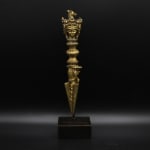Sino Tibetan Dagger, 18th century CE
height 21 cm
height 8 1/4 in
Dimensions provided without mounting.
height 8 1/4 in
Dimensions provided without mounting.
LI.3185
Further images
This stunning traditional Tibetan dagger, or phurba is a stunning brass example of Buddhist craftsmanship, featuring three faces of the meditational deity Vajrakīla, on the pommel. The Tibetan phurba is...
This stunning traditional Tibetan dagger, or phurba is a stunning brass example of Buddhist craftsmanship, featuring three faces of the meditational deity Vajrakīla, on the pommel. The Tibetan phurba is a three-sided ritual dagger, usually associated with Indo-Tibetan Buddhism, Bön and Indian traditions. The phurba appears with a variety of handle and blade designs, but the basic elements usually include a pommel, handle, and a blade. They are typically made of iron and brass, prized and typical of most traditional Tibetan metal instruments. Phurbas, including this example, often feature Vajrakīla, who embodies the enlightened activity of all the Buddhas and his three expressions–joyful, peaceful, and wrathful. The handle, as seen here, is usually adorned with vajra–a woven or knotwork design. The unique blade features three faces, representing its power to transform negative energies or “three poisons” of attachment, craving, and desire; delusion, ignorance, and misconception; and aversion, fear, and hate. The phurba was typically used in ritual ceremonies, where it is pierced into the ground to signify the stability of a prayer ground during ceremonies. Today, the phurba is commonly used by shamans, tantrikas, and lamas of the Kathmandu Valley, where it can be used for meditation, healing, and spiritual transcendence.













